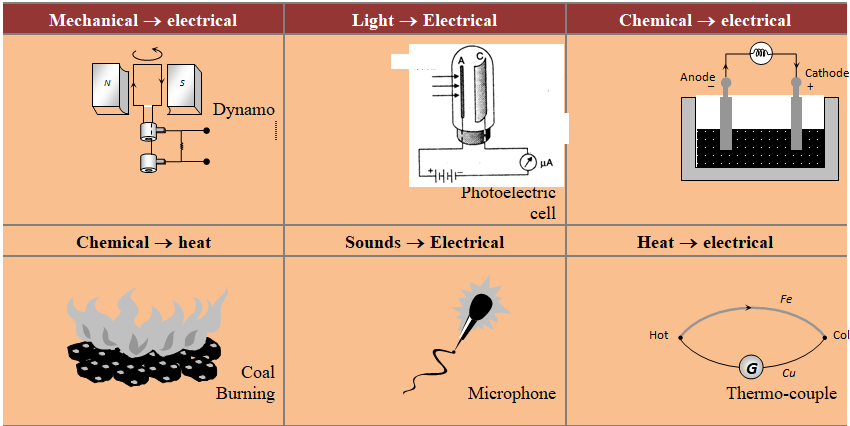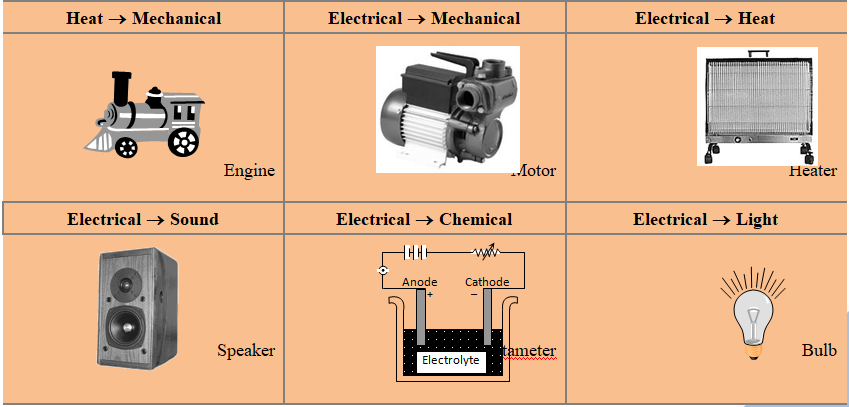
Energy Conversions Or Energy Transformation
Work, Power and Energy of Class 9
Energy Conversions Or Energy Transformation
(i) An Electric motor used in electric fans, washing machines, refrigerators, mixer and grinder etc. convert
Electrical energy → Mechanical energy.
(ii) A Generator converts
Mechanical energy → Electrical energy.
(iii) An Electric Iron converts
Electrical energy → Heat Energy
(iv) An Electric Heater converts
Electrical Energy → Heat Energy
(v) An Electric Bulb converts
Electrical Energy → Heat Energy → Light Energy
In an electric bulb flow of electricity causes the tungsten filament in the bulb to become white hot and give out light. So in an electric bulb the energy transformation takes place as follows :
- Solar Cell : Light Energy → Electrical Energy
- Solar Heater : Light Energy → Heat Energy
- Burning LPG : Chemical Energy → Heat Energy + Light Energy
- Cell or Battery : Chemical Energy → Electrical Energy
- Car Engine : It converts the chemical energy of petrol into heat energy and then into kinetic energy or mechanical energy.
Chemical → Heat → Kinetic Energy or Mechanical Energy
- Steam Engine: Heat Energy → Kinetic Energy
- Radio: Electrical Energy → Kinetic Energy of diaphragm in speaker→ Sound Energy
- At thermal power station: Chemical energy → Heat Energy → Kinetic Energy → Electrical Energy.
When coal is burnt, the chemical energy of coal is changed into heat energy. This heat energy converts water into steam. The high pressure steam turns the steam turbines changing the heat energy into kinetic energy. The turbines run electricity generators which convert kinetic energy into electrical energy.
Few more examples


COMMERCIAL UNIT OF ENERGY:
The commercial unit of energy is kWh (Kilowatt hour).
The unit ‘joule’ is too small and hence is inconvenient to express large quantities of energy, so we use kWh as unit of energy for commercial purposes.
1 kWh is the amount of electrical energy consumed when an electrical appliance having a power rating of 1 kilowatt is used for 1 hour.
The energy used in households, industries and commercial establishments are usually expressed in kilowatt hour. For e.g. electrical energy used during a month is expressed in terms of ‘units’. Here, 1 ‘unit’ means 1 kWh or BOTU (Board of Trade unit).
Question 1 How much work should be done on a bicycle of mass 20 kg to increase its speed from 2 m/s to 5 m/s?
Solution: Ist Case: m = 20 kg


IInd Case : m = 20 kg



= 250 J
Work done = Change in kinetic energy
= 250 – 40
= 210 J
Question 2 A car of mass 1000 kg traveling at 30 m/s stops at a distance of 50 m decelerating uniformly. What is the force exerted by it on the brakes? What is the work done by the brakes?
Solution:
u = 30 m/s, S = 50 m
v = 0, a = ?
v 2 = u 2 + 2as
(0) 2 = (30) 2 + 2a (50)
0 – 900 = 100a

a = –9 m/s 2
F = m × a
F = 1000 × –9
F = –9000 N
Work done by brakes on the car
W = F × s
W = 9000 × 50
= 450,000
W = 4.5 × 10 5 J
Related Topics





